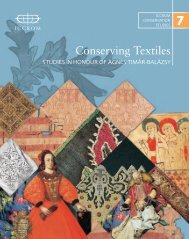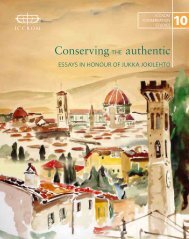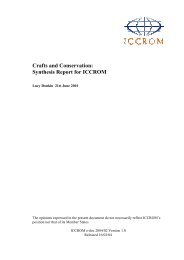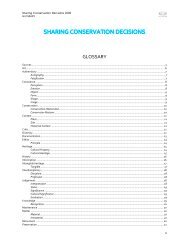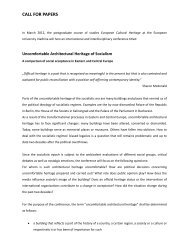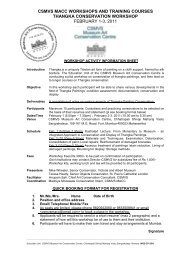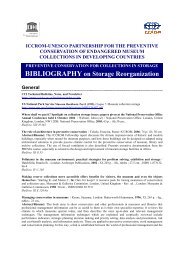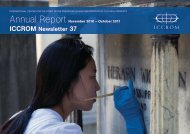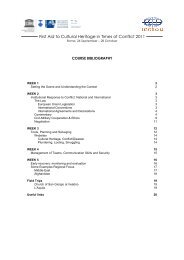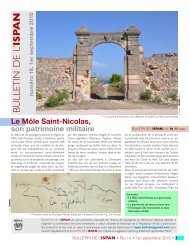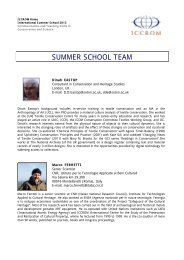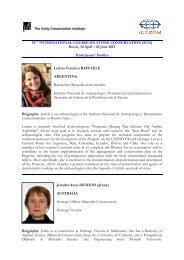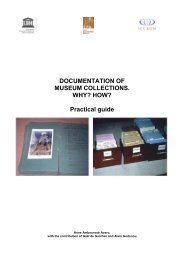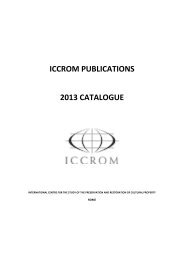part 1 - Iccrom
part 1 - Iccrom
part 1 - Iccrom
Create successful ePaper yourself
Turn your PDF publications into a flip-book with our unique Google optimized e-Paper software.
MEASURING HERITAGE CONSERVATION PERFORMANCE<br />
6th International Seminar on Urban Conservation<br />
the dark. There is nearly no street public equipment<br />
like benches etc., only a monument commemorating<br />
the city’s foundation. Nevertheless, along the<br />
Rua Sagrado Coração de Jesus is a longer balustrade<br />
that is the haunt of the people in front of the prefeitura,<br />
called murinho (‘little wall’).<br />
Figure 3. Feiralivre, the historic pavement and the Mercado<br />
building.<br />
The commercial town centre is a pedestrian area<br />
(the former Rua Direita do Comércio) directly leading<br />
to the market square (now called Rua Getúlio<br />
Vargas) and contains two small supermarkets, some<br />
bars, a bank and several shops. Along both sides of<br />
the square are found some simple bars and shops,<br />
all the local hardware stores, and also some waste<br />
houses or ruins (some of them currently undergoing<br />
a kind of ‘reconstruction’). At the east end the main<br />
bus station (rodoviária) was built. Sometimes the<br />
neighbourhood opposite Trapiche gives shelter to<br />
some tables with handicrafts. Besides the prefeitura,<br />
the most important building is the listed covered<br />
mercado, to be opened at three sides to the market by<br />
many wooden doors (see Figure 3). In the western<br />
Trapiche buildings leading to the university the main<br />
entrance is just outside the market zone, not affecting<br />
the popular event. Their many doors are shut<br />
everyday, which gives the recently restored buildings<br />
a strangely ambivalent character. The mercado<br />
is also closed during the week but every door opens<br />
widely on market-days.<br />
2. Attainability<br />
The realm of the feira livre has many different<br />
accesses (see Figure 1). The possible former direct<br />
route from the countryside now connects only some<br />
areas of simple detached houses with the centre,<br />
leading across the river over a small road bridge. Its<br />
former direct (visual) importance was probably lost<br />
because of the construction of the other bridges the<br />
mercado building cuts off in the 19 th century. Today<br />
there are two different main access points at the eastern<br />
and western end of the market square, by which<br />
the people of some suburbs of Laranjeiras and its<br />
surrounding villages reach the market. In <strong>part</strong>icular,<br />
on Saturdays public buses are organized that<br />
wait there for the tour back to the villages, guarding<br />
in the meantime the many bags and plastic sacks<br />
of purchases and foodstuffs. The southern access is<br />
divided among some streets and lanes. Motorized<br />
visitors drive mostly into the Rua Sagrado Coração<br />
de Jesus. Other consumers who walk to the market<br />
mainly use the central pedestrian street, ‘Rua Direita’<br />
as it is still called by the people. A very special<br />
inland manner of coming to the market is by mototaxi,<br />
or motorcycle. At every access where motorized<br />
traffic reaches directly the market, motorcyclists<br />
park their vehicles until someone wants to be transported<br />
homeward. Another more traditional way of<br />
visiting the market is by horse, generally pulling a<br />
little wooden cart. Some people still do this and let<br />
their horses wait at two common places. We exemplify<br />
the variety and details of going to the market<br />
in order to expose the various underlying ‘scripts’<br />
emerging into a functional substructure behind the<br />
‘picturesque image of a Brazilian market’, exploring<br />
a complex socio-spatial entity.<br />
The way back home might be the same but is visibly<br />
different because of the many sacks and bags<br />
that must be transported. The professional mototaxista<br />
offers his backseat to the customer and all<br />
purchases are mounted between him and the transported<br />
person. People sit waiting on the sidewalks,<br />
while someone is searching around for a last article,<br />
surrounded by a pack of bags until the taxi or one’s<br />
car is loaded with all goods. Many of the pedestrians<br />
rent a carregador, who wait at common places for<br />
a job. If hired, these young boys follow the customer<br />
on the market through the swarm of people and collect<br />
every bag, melon, vegetable and other purchase<br />
in their metal wheelbarrow (carreta). In the end the<br />
consumer is joined by the boy on the way home,<br />
sometimes pushing a heavy load.<br />
Brendle, K. H. 2012. ¿Conservar uma feira livre? Or, preserving dynamic, complex heritage by accenting societal character and sociospatial<br />
conceptualization. In Zancheti, S. M. & K. Similä, eds. Measuring heritage conservation performance, pp. 42-52. Rome, ICCROM.<br />
44



